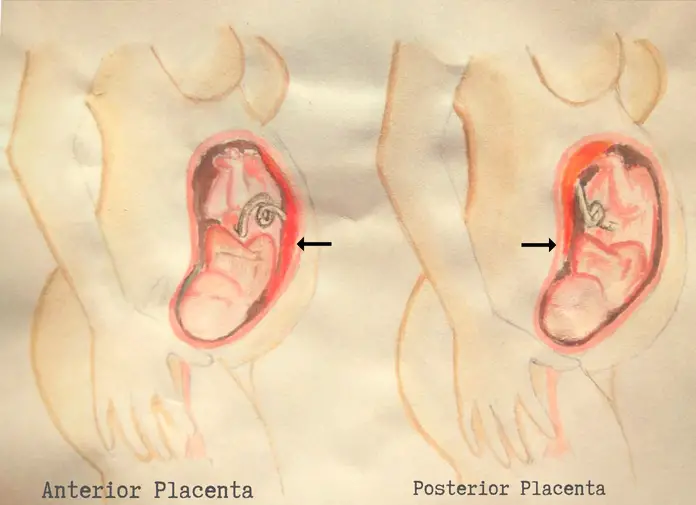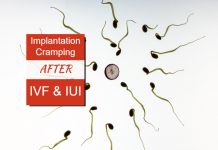In anterior placenta a problem? Anterior placenta is not an abnormality. Unless the placenta slides down to cover the cervix and causes Placenta Previa, there is nothing to worry. Hearing fetal heartbeat becomes difficult in such condition. Performing C-section also becomes risky with an anteriorly located placenta.
Just returned from your scan that showed an anterior placenta?
While there is nothing to worry if your placenta is located anteriorly, you may still be curious.
FYI – Anterior is front and Posterior is back in medical terminology.
Every pregnancy complication has a way out; an anterior placenta is not a problem though.
Want to learn more about it? Read the next sections patiently.
What is an anterior placenta?
An anterior placenta is when the placenta comes to the front wall of the womb. In simple terms, the placenta is attached to the belly side.
The placenta can be lateral, posterior, anterior or fundal. The lateral placenta is towards sides; posterior is at the back and fundal at the top wall of the womb.
Especially for women who plan to have a c section, the anterior placenta may become an obstacle. Baby’s movements soften due to the cushion in between.
The placenta is an organ that forms in the uterus from the egg layers during pregnancy to nourish your baby. As pregnancy progresses, your baby switches obtaining nutrients from the yolk to the placenta.
A placenta has a lot of blood vessels and helps the baby get nutrients and throw out waste. Location of the placenta is critical for the health of the pregnancy.
If the placenta is low lying and covers the cervix, the condition of Placenta Previa is life-threatening.
Usually, the tissue attaches to the back wall and is the posterior placenta. In some cases, it moves up the wall of the uterus and is known as the fundal placenta.
It becomes a barrier for feeling baby’s movements or hearing the fetal heartbeat.

Why do I have an anterior placenta?
The reason for having an anterior placenta is merely the implantation site. Fertilization of the egg occurs in the fallopian tube, and it travels down to attach in the uterus.
The spot at which the egg affixes is implantation site and placenta forms there. If the egg gets attached to the front wall, the placenta is anterior.
At times incision of the previous C-Section causes the placenta to build up through the womb. This condition is Placenta Accreta and makes positioning the C-section incision difficult.
A C-Section wound or anterior placenta increases the risk of Placenta Accreta complication.
How does anterior placenta affect baby’s position?
The placenta is a unique endocrine gland. This gland’s position doesn’t affect the baby’s position or growth.
In the second stage of labor, the baby is delivered. During the third stage and the last stage of labor, the placenta is delivered. Delayed cord clamping ensures that the extra blood from the placenta reaches the baby.
But an anterior placenta has the risk of coming out first during a C-Section. That can lead to heavy bleeding.
Typically, this doesn’t occur, and the only issue is fall in intensity of kicks and touches. Even anteriorly, the placenta continues to nourish the baby just like other positions of the placenta.
When will you know that your placenta is anterior?
The 20-week scan has more to reveal than just your baby’s sex. An anomaly scan during week 20 of pregnancy shows whether you have an anterior placenta.
By the time you must have gone through difficulties like not being able to hear the heartbeat using the fetoscope.
And in the coming weeks, the placenta will move out of the path of your baby. Ironically, when you find out why, the reason will no longer exist!
Low lying anterior placenta threatens Placenta Previa. In the later stages, even low lying placenta moves behind, pushed by the baby’s movements.
Belly mapping is locating the baby before labor. The right baby position affects the length and course of labor. It will also determine whether you will have an inverted baby.
When will you feel baby’s movements with the anterior placenta?
Baby movements and anterior placenta won’t interfere with each other. As a precautionary measure be extra-careful about baby fluttering. If you don’t feel the movements in the 24-week pregnant time, consult your doctor.
Anterior placenta only lowers the intensity of the baby’s movements. You will still be able to feel them and that too timely. Sleep awake patterns of the baby will register in your mind. It will not be that difficult to make out movements of the baby.
When can you hear the fetal heartbeat with the anterior placenta?
A fetoscope like a stethoscope helps to hear the heartbeat of your baby. Unlike the doppler fetal heartbeat monitor, there are no ultrasound waves.
With an anterior placenta, you will hear your pulse using a fetoscope. The blood pumping in the placenta is through your circulation.
Thus, the beat will be your own until you get to the right position to hear the fetal heartbeat.
Even doctors will take time to locate the baby’s heartbeat. At times to your disappointment, they might not find it.
The anterior placenta will mask the heartbeat making you spend a few extra bucks for an ultrasound. Other than that there are no severe health complications due to the condition of the uncommon location of the placenta.
Does anterior placenta cause labor complications and heavy bleeding?
One of the potential complications from the anterior placenta is the risk of Placenta Previa.
A normal placenta grows towards the side of uterus richly supplied with blood vessels. Anterior placenta might grow down and cover the mouth of the cervix. Just like the mucus plug, the placenta would seal the mouth of the cervix.
The barrier will stop the baby from passing out from the birth canal and call for a C-section.
Similarly, those who want to get a C-section but have anterior placenta will be at risk of bleeding. The blood bag will be between the baby and c section site.
For performing amniocentesis, the doctor aspirates amniotic fluid from the bump. Placenta in between the sac and belly skin will risk blood coming out instead of amniotic fluid.
Location of the placenta will make belly mapping difficult in case of the planned C-section. Your doctor might put a higher incision during the C-Section.
Anterior placenta, Birth and Baby Position
Occipital posterior (OP) position of the baby is when the face is in the same direction as mother’s face. It means that the baby is reclining with back on mom’s back.
When the OP position and anterior placenta are concurrent, there may be labor difficulties. An OP baby takes longer labor or starts back labor.
Studies do suggest that OP position occurs when the mother has an anterior placenta. With the cushion in the front baby prefers the OP position.
The placenta can move! During the later stages the anterior placenta shifts to the posterior wall. So, all the theoretical complications of anterior placenta don’t arise in reality in most cases.
What can I do if I have an anterior placenta?
Specific inversion and movement exercises can move the baby and placenta.
Swimming and stretches from the 20 weeks are easy ways to move and anterior placenta.
Use a Doppler device to hear the heartbeat of the baby. Call your doctor immediately if you sense no movements.
Let gravity work and sleep with supporting maternity cushions.
For those who are reading this while TTC, lie on your back to let gravity pull the egg back.
Emergency C-section due to other complications occurs in many cases. Situations arise even with mothers who had a posterior placenta and everything perfectly fine.
Stop worrying; you got this momma!




![Implantation Bleeding With Twins [How long does IB last with twins?] Implantation Bleeding With Twins](https://www.pregnanteve.com/wp-content/uploads/2019/01/implantation-bleeding-with-twins-218x150.jpg)




